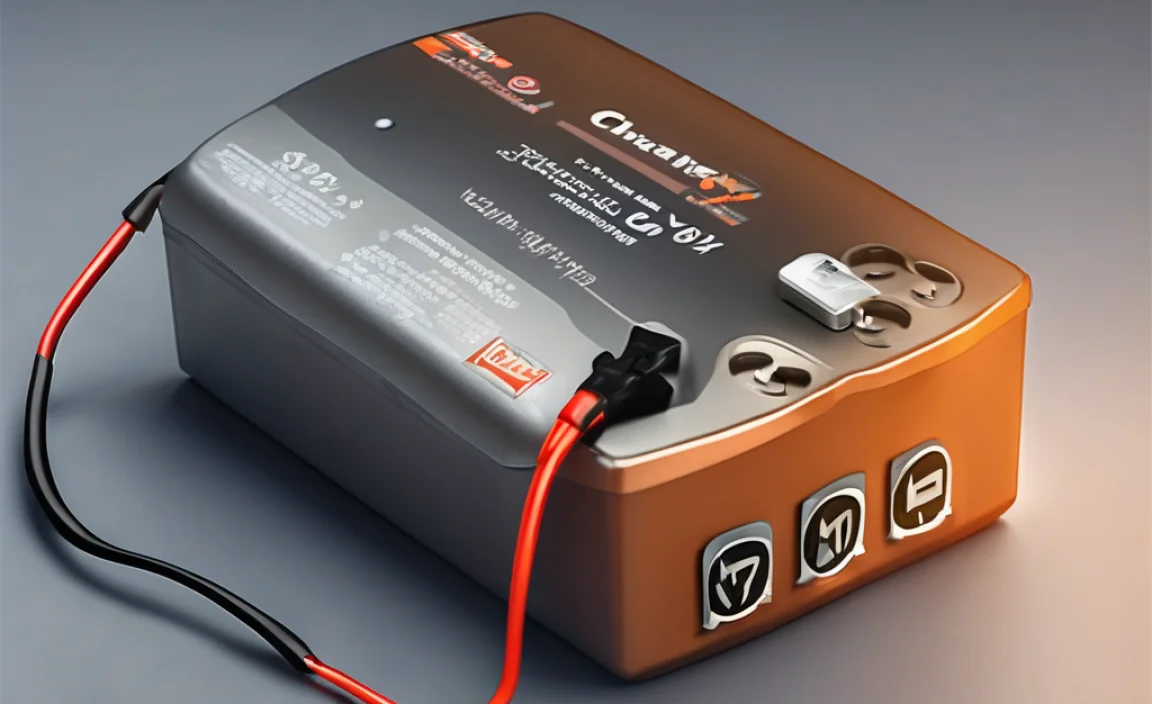You need a Type A or Type B plug adapter for Japan, as its outlets are different from many other countries. Japan uses 100V electricity, so check if your devices are compatible before you go. Most modern electronics like phones and laptops are dual-voltage, but it’s always smart to double-check.
Going to Japan is exciting, and you’re probably busy planning all the amazing things you’ll see and do. But have you thought about keeping your gadgets charged? It’s a common hiccup for travelers: you arrive, ready to share your adventures, only to find your phone won’t plug in! It can be a real bummer, leaving you disconnected and scrambling for a solution. Don’t let power outlets be a surprise spoiler for your trip. This guide is here to make things super simple, so you know exactly what power adapter you need for Japan. We’ll break down the types of plugs, voltage, and what to look for, ensuring you stay powered up and connected from the moment you land. Let’s get your electronics ready for Japan!
Understanding Japan’s Electrical System
Japan’s electrical system has a few key differences from what you might be used to, especially if you’re coming from North America, Europe, or elsewhere. Knowing these details upfront will save you a lot of hassle and potential damage to your valuable electronics.
Voltage in Japan
The most crucial difference is the voltage. Japan operates on a 100-volt (V) supply. This is lower than the 110-120V common in North America and significantly lower than the 220-240V used in most of Europe and many other parts of the world.
Why does this matter? Well, electronics are designed to work within a specific voltage range. If you plug a device not designed for 100V into a higher voltage outlet, it can overheat and get damaged. Conversely, if you plug a device designed for 220-240V into Japan’s 100V system, it might not work at all, or it might perform poorly.
The good news: Most modern electronic devices today are “dual-voltage” or “multi-voltage.” This means they can automatically adjust to different voltage inputs, usually between 100V and 240V. You can often find this information on the device’s power adapter (the brick part of the charger) or the device itself.
Look for text like:
- “INPUT: 100-240V”
- “AC INPUT: 100V~240V”
- “UNIVERSAL POWER SUPPLY”
If you see this, great! You likely won’t need a voltage converter, just a physical adapter to fit the plug into the wall socket. If your device only says “INPUT: 100V” or “INPUT: 110V,” then you will need a voltage converter to safely use it in Japan.
Frequency (Hertz)
Another difference, though less critical for most travelers, is the frequency. Japan uses 50 Hertz (Hz). In North America, it’s 60Hz. While this difference can affect the performance of some high-power appliances (like motors in blenders or hair dryers), most modern electronics like phones, laptops, and cameras are less sensitive to this variation. Again, dual-voltage devices are usually designed to handle this difference too.
Japan’s Power Plugs and Sockets
This is where the adapter comes in. Japan primarily uses two types of plugs and sockets, both of which are ungrounded:
Type A Plugs
This is the most common type in Japan. It features two flat, parallel pins. These pins are identical to the ungrounded plugs used in North America (like for your phone charger), but with a key difference: Japanese Type A pins are not polarized. This means they are the same size and shape, and you can insert them into the socket either way up. Many older North American outlets feature one larger pin (polarized plug), which won’t fit cleanly into a Japanese Type A socket.
You’ll find these very commonly for most household appliances and electronics.
Type B Plugs (Less Common for Electronics)
While Type A is dominant, you might occasionally encounter Type B sockets. These are identical to the Type A sockets but have an additional, round grounding pin that descends from the two flat pins. However, most devices used in Japan are ungrounded and hence use Type A plugs. If you have a device with a Type B plug (three pins, with one round grounding pin), it’s less likely to be compatible with Japan’s standard outlets.
Important Note: Japan does not use the common European Type C (“Europlug”), Type F (“Schuko”), or Type G (UK) plugs. If you’re coming from these regions, you will definitely need an adapter.
What Sockets Will I See?
The vast majority of power outlets you’ll encounter in hotels, homes, and public spaces in Japan will be designed for Type A plugs (two flat, ungrounded pins). They look very similar to North American outlets, minus the potential polarization. The holes for the flat pins are parallel and of the same size.
Here’s a quick visual guide:
Type A Socket (Japan): Two parallel, vertical slots. Similar to North American outlets, but typically unpolarized, meaning the slots are the same size.
Type B Socket (Japan): Two parallel, vertical slots with a rounded hole below for a third grounding pin. Less common than Type A.
Choosing the Right Power Adapter and Converter
Now that you understand Japan’s electrical system, let’s talk about what you actually need to buy. This is where most people get confused, so let’s break it down clearly.
Power Adapter vs. Voltage Converter vs. Transformer
It’s essential to know the difference:
- Power Adapter (Plug Adapter): This is a physical device that changes the shape of your plug to fit into a foreign socket. It does not change the voltage. It’s simply a mechanical connector.
- Voltage Converter: This device converts the voltage from a foreign outlet (e.g., 100V in Japan) to a lower voltage that your appliance can accept (e.g., 230V). These are usually bulky and designed for heating appliances (like hair dryers, curling irons) that don’t have dual-voltage capabilities. They often have simple circuitry.
- Voltage Transformer: This is a more sophisticated and often heavier device that converts voltage and can also handle different frequencies. They are generally recommended for sensitive electronics or appliances that are not dual-voltage.
What Most Travelers Need for Japan
For the vast majority of modern portable electronics (smartphones, tablets, laptops, digital cameras, power banks), you will primarily need a simple power adapter (also called a plug adapter). This is because these devices are almost always dual-voltage (100-240V).
The adapter needs to convert your country’s plug type (e.g., Type B for North America, Type G for the UK, Type C for Europe) into Japan’s Type A plug.
When You Might Need a Voltage Converter
You only need a voltage converter (or transformer) if you are bringing appliances that are not dual-voltage and are designed for a higher voltage system (like 220-240V). Common examples include:
- Older, high-wattage hair dryers
- Styling irons (curling irons, straighteners) that are not specifically labeled as dual-voltage
- Some older electric razors
- Certain travel appliances like small kettles or irons
Crucial Advice: Always check the label on your appliance or its power cord. If it says “100V” or “110V” only, or if it has no input voltage listed, do not plug it into a Japanese outlet without a voltage converter rated for 100V input and your appliance’s voltage output. Using a non-dual-voltage appliance without a converter can damage your appliance or even cause a fire. For devices like hair dryers, it’s often more practical and safer to buy a cheap one once you arrive in Japan, or to use one provided by your accommodation.
Choosing a Universal Adapter
For convenience, many travelers opt for a “universal travel adapter.” These are clever little devices that have interchangeable plugs for different regions of the world, including Japan. They often include a USB port as well, allowing you to charge multiple devices at once.
When buying a universal adapter, ensure it specifically lists compatibility with Japan’s Type A outlets. Look for one that is compact, lightweight, and made by a reputable brand. This single adapter can then serve you on future trips to many other countries.
A good universal adapter will typically have:
- Retractable or interchangeable pins for various countries (including Japan’s Type A).
- A built-in surge protector for added safety.
- One or more USB ports for charging smaller devices.
- A switch or mechanism to select the correct plug type.
Ensure your universal adapter uses a robust mechanism for switching pins to avoid accidental dislodgment.
Practical Steps: What to Pack and How to Use It
Let’s get practical. Here’s a step-by-step guide to ensure you’re prepared:
Step 1: Check Your Devices
Before you even think about adapters, go through all the electronics you plan to bring. For each device, find its power adapter (the charging brick for phones, laptops, etc.) or the label on the device itself. Look for the “INPUT” voltage information.
Example:
- Smartphone Charger: “INPUT: 100-240V, 50/60Hz” – This is dual-voltage. You only need a plug adapter.
- Laptop Charger: “INPUT: 100-240V ~ 2.5A” – Also dual-voltage. Needs only a plug adapter.
- Hair Dryer (Older): “INPUT: 220-240V” – This is NOT dual-voltage. You will need a voltage converter OR leave it at home/buy one there.
Step 2: Identify Your Needs (Adapter or Converter?)
Based on Step 1:
- If all your devices are dual-voltage (most modern electronics are), you only need a plug adapter that fits your home country’s plugs and converts them to Japan’s Type A sockets.
- If you have any non-dual-voltage appliances (especially heating appliances), you also need a voltage converter or transformer that matches the appliance’s voltage requirements. Be aware that converters can be heavy and less convenient.
Step 3: Purchase the Correct Adapter/Converter
- For Plug Adapter: Buy a “Japan plug adapter” or a “Type A plug adapter.” Alternatively, purchase a good quality “universal travel adapter” that explicitly states it includes Type A plugs.
- For Voltage Converter: If needed, buy a voltage converter. Make sure it is rated for the correct wattage for your appliance (check the appliance’s power consumption in watts) and that it is designed to step down from 100V to your appliance’s voltage (e.g., 100V to 240V).
Where to Buy:
- Online: Amazon, Best Buy, dedicated travel accessory websites.
- In Stores: Electronics stores, travel specialty stores, and sometimes large department stores.
It’s always best to buy these items before your trip so you’re not scrambling at the airport or upon arrival. For example, a common and reliable option is to search for “Japan travel plug adapter” on Amazon. Many reputable brands offer these.
Step 4: How to Use Your Adapter in Japan
Using the adapter is straightforward:
- Plug the adapter into the Japanese wall socket. The flat pins of the adapter will insert directly into the Type A socket.
- Plug your device’s power cord into the adapter. If you have a universal adapter, select the appropriate country’s plug configuration (Japan’s Type A) and then plug your device in.
- Turn on your device. For dual-voltage devices, they will automatically work with Japan’s 100V. For non-dual-voltage devices with a converter, ensure the converter is switched on and working.
Step 5: Consider Charging Multiple Devices
If you’re traveling with a smartphone, camera, and other gadgets, you might run out of outlets. Here are some solutions:
- Universal Adapters with USB Ports: Ideal for charging phones and tablets directly.
- Multi-outlet Adapters: Once you’ve plugged in your primary adapter, you can plug these into it to gain extra sockets.
- Power Strips with USB: If your accommodation has a few outlets, a small power strip can be very useful for charging multiple items simultaneously.
- Portable Power Banks: A fully charged power bank can be a lifesaver when you’re on the go and away from an outlet.
Safety Tips!
Always remember to:
- Never force an adapter or plug into a socket. If it doesn’t fit easily, it’s probably the wrong type.
- Ensure your adapter is rated for the correct voltage and amperage for your devices, especially if using a converter.
- Unplug your devices when not in use, especially if you are concerned about power fluctuations.
- Keep adapters and converters away from water.
- If an adapter or converter feels excessively hot, smells unusual, or sparks, unplug it immediately and do not use it.
Japan Plug Adapter vs. Voltage Converter: A Quick Comparison Table
To help you decide, here’s a clear comparison between what you likely need.
| Feature | Power Adapter (Plug Adapter) | Voltage Converter/Transformer |
|---|---|---|
| Primary Function | Changes the physical shape of the plug to fit foreign sockets. | Changes the electrical voltage from one level to another. |
| Does it change voltage? | No. | Yes. |
| When is it needed for Japan? | Almost always, if your home country’s plugs differ from Japan’s Type A. | Only if you bring non-dual-voltage appliances (e.g., 220-240V appliances into Japan’s 100V system) that are not designed to handle lower voltages. |
| Common Devices Used With | Smartphones, laptops, tablets, cameras, power banks, most modern electronics. | Hair dryers, curling irons, older or specialized appliances not labeled “dual-voltage” or “100-240V”. |
| Size & Weight | Usually small, lightweight, and portable. | Can be bulky, heavy, and less portable, especially for higher-wattage devices. |
| Cost | Generally inexpensive ($5 – $20 for a basic one, $20 – $40 for universal). | Can range from $20 to $100+, depending on wattage and type. |
| What to check | That it has Japan’s Type A plug configuration. | Correct input/output voltage, sufficient wattage for the appliance, and reputable brand. |
Common Mistakes to Avoid
Traveling is wonderfully chaotic, but let’s try to avoid these common blunders when it comes to power in Japan:
Mistake 1: Assuming your plugs will fit. This is the most frequent error. While Type A plugs look similar to North American plugs, the lack of polarization on Japanese sockets can be an issue for plugs designed with one larger pin.
Mistake 2: Forgetting to check device voltage. Plugging a 240V-only device into Japan’s 100V grid usually means it just won’t work. However, plugging a 100V-only device into a higher voltage outlet (if you mistakenly used a converter improperly or were in a different country) can be dangerous and damage the device.
Mistake 3: Buying the wrong type of adapter. Many people buy a simple plug adapter when they actually need a voltage converter, or vice versa. Always read the labels and understand the difference.</




